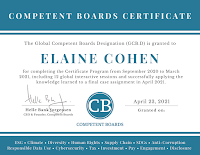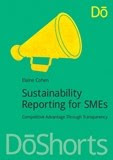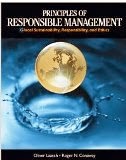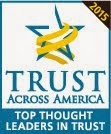In the run-up to G4 (to be launched in May at the GRI conference), I decided to examine some recent reports (at random, but GRI-based and broadly same sector) to see if they would be good-to-go if the Exposure Draft is approved as published (albeit the likelihood of this appears low - the grapevine is indicating that significant stakeholder pushback is likely to dilute G4, though quite to what extent is not clear).
Below is a reminder of what reports must include in order to qualify as "In Accordance" with the potential G4 Framework as we know it today from the Exposure Draft:
1. All of the Profile Disclosure Items. (There are 73 (!) Profile Disclosures)
2. Disclosures on Management Approach and Core Indicators related to all of the material Aspects identified by applying the Technical Protocol: Defining Report Content and Boundaries.
3. All disclosures identified in any applicable GRI Sector Supplement(s).
4. A GRI Content Index as specified in the GRI Guidelines.
5. A statement, signed by the highest governance body or Chief Executive Officer (CEO), that the report has been prepared in accordance with the GRI Guidelines and that it is a balanced and reasonable presentation of the organization’s economic, environmental and social impacts.
Regarding Profile disclosures, there are four substantive disclosures in G4 which make a difference to the entire reporting content. These are:
DI 12: Describe the organization's supply chain (number, type, location of suppliers, value of materials purchased etc)
DI 17: List the identified material Aspects (and other material topics).
DI 18: Describe the organization’s value chain.
DI 19: Place material Aspects (or other material topics) in the value chain.
Not reporting on these Profile Disclosures invalidates the "In Accordance" adherence. I will focus on these in my review of reports.
I ignore the 38 (!) Profile Disclosure items relating to governance and remuneration (up from 10 disclosure Items in G3), as, in my view, many of them are irrelevant, unnecessary and a waste of hours that the Working Group invested in devising every data point that they could possibly imagine. I expect this justified the cost of bringing the group to Amsterdam, but, in my view, it makes sustainability reporting look like Amazon.com's inventory of items shipped in the last five years. I suspect that in almost every case, these 38 disclosures alone will disqualify all existing reports from claiming "In Accordance". However, let's not get bogged down in the negatives before we even started....
Regarding Disclosures on Management Approach, there are now three specific disclosures (replacing rather general guidance in G3) which require the company to report for each material issue (aspect), what the issue is and its key impacts, why it is material and what it's doing about it.
First guinea pig:
The Clorox Company
GRI B+ GRI-checked online report with download (78 pages) Household Cleaning Products
Quick Overview of the Report
Clorox is a $5.5billion household products business with markets in over 100 countries and a workforce of 8,400 people. At Clorox, sustainability is paying off. Clorox people write in their annual report: "Sustainability investments in our Burt’s Bees®, Glad®, Brita® and Green Works® brands have accounted for about 40 percent of our sales growth in the last five years. Additionally, we’ve saved about $15 million annually by making sustainability improvements to our operations." A nice touch in this report is a description of some megatrends that are influencing Clorox's thinking. Clorox's Ingredients Inside is an interesting initiative, which lists all raw materials used in Clorox's cleaning products, with their chemical names and function. Of course, you would have to have a PhD in chemistry to make sense of all of that, but it's a good step for transparency.
The report receives a "+" from the GRI for being assured, although only GHG emissions from electricity consumption in U.S. facilities were verified. Frankly, you couldn't find a smaller sample of disclosure to assure, even if you tried really really really hard. This report, to me, does not stand the test of assurance. I fail to see how the GRI can reasonably award a certificate for assurance here.
The well-respected Leon Kaye's concludes in his review of this report that "Clorox stands out as a corporate citizen that more companies within and outside of its space would be wise to emulate". Certainly the company demonstrates strong performance in waste reduction, GHG emissions, and water consumption. I note some positive employee practices including a new health and wellness program and also good community support.
However, I feel the Clorox report lacks some reporting depth and breadth, and is focused on activities rather than the change that Clorox is effecting in society as a result of its sustainable business focus. For example, 21% of products (since 2010) have been reformulated to reduce materials and waste, but Clorox does not disclose the extent of these improvements and the reduction in impact. There is a commitment to "responsible sourcing" but zero detail on what this actually means, beyond the existence of a Supplier Code of Conduct. More importantly, there is little about how Clorox is changing consumer behaviors with the exception of one or two small examples. With key business growth coming from "green"-ish products, I would have appreciated Clorox telling this story more fully.
Profile Disclosures:
Clorox lists four issues of material focus, based on insights gained from stakeholder engagement processes:
- Sustainable Product Innovation to include solutions for public health and more natural or plant-based products.
- Product responsibility to improve human and environmental safety and ingredient transparency.
- Environmental sustainability for reducing Clorox's eco footprint.
- Public health in the area of disinfecting products.
Looking at G4's matrix of Categories and Aspects, these appear to be just two aspects: Environment (emissions, effluent and waste aspect) and Product Responsibility (customer health and safety aspect). This is quite convenient for Clorox, as the performance indicator content of G4 is required only for Material Aspects. An opportunity to move from 78 pages to 20 :)
Clorox does not describe its Supply Chain, nor its Value Chain and does not place material aspects in the Value Chain. These are required G4 disclosures. G4 good-to-go? NO
As an aside, another interesting Clorox issue which invited the wrath of leading commentator Marc Gunther and several others was their Greenworks campaign, which was too late for this report but may (or may not) be mentioned in the next report. Perhaps it's something for the Material Aspect: Marketing Communications!
Disclosures on Management Approach
This is easy for Clorox as there are only two Aspects to report. I think this report meets the requirements for this section.G4 good-to-go? YES
Performance Indicators
There are 10 indicators which are in the Emissions, effluent and waste Aspect (EN16 - EN25), of which seven are core. Clorox currently reports on three of these seven core indicators in full, providing no data relating to, for example, water discharge (EN21) or significant spills (EN23), and avoiding non-core indicators such as hazardous waste (EN24) and biodiversity affected by water runoff (EN25). G4 good-to-go? NO
There are just two Performance Indicators in the Customer Health and Safety Aspect (PR1, PR2) and Clorox currently reports on one of them, providing a good description of safety assessments and procedures (PR1). Clorox does not report on incidents of non-compliance with regulations concerning the health and safety impacts of products during their life cycle (PR2), but this is non-core, so not required for "In Accordance". G4 good-to-go? YES
Despite producing a lengthy and generally comprehensive report using G3, and recording some good sustainability achievements, it looks like Clorox has quite some work to do in order to prepare future reports "In Accordance" with the G4 Exposure Draft. And this is based on an analysis which barely grazes the surface of the total new scope of G4. I believe this shows that G4 as proposed is not a small evolution for reporting, but a major overhaul, and will require significant reconsideration of what and how to report. The upside is that Clorox G4 will not be required to report on anything not defined as material. But is that really an upside? Are there not some disclosures which should be reported by all companies whether or not they are company-specifically-material? I suspect there are several.
At least Clorox will not be alone in having to make significant change if the company decides to adopt G4... watch this space for an example from Henkel's report in my next post.
At least Clorox will not be alone in having to make significant change if the company decides to adopt G4... watch this space for an example from Henkel's report in my next post.




















No comments:
Post a Comment